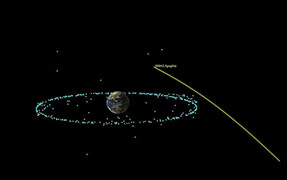Spintronics aided by terahertz exposure
Because spin photocurrents occur in homogeneous, unbiased samples under uniform irradiation, the effect is very different from photovoltaic currents, which are caused by charge separation at potential barriers. These currents have been studied in various materials over a wide range of temperatures, including the technologically important room temperature.
In contrast to higher-energy, inter-band excitations, the terahertz (THz) spectral range has the advantage that it involves only one kind of carrier, electrons or holes, yielding unipolar spin orientation. Two mechanisms by which THz excitation can generate a spin photocurrent have been investigated in detail: the circular photogalvanic effect (CPGE)4 and the optically induced spin-galvanic effect (SGE).5
A characteristic feature of a spin photocurrent, j, is that it reverses direction, j→ −j, when the radiation helicity is changed, for example from right-handed circular to left-handed circular, σ+→σ−. The photocurrent is proportional to the helicity, Pcirc.6,7 This dependence is illustrated in Figure 1 for p-GaAs QWs. The experimental arrangement is shown in the inset. In these low-symmetry, (113)-grown QWs, the spin photocurrent occurs for radiation at normal incidence, but in (001)-oriented samples a helicity-dependent signal is observed only at oblique incidence due to the higher symmetry.

The spin photocurrent results from an asymmetric momentum distribution of photoexcited carriers, which in turn reflects terms in the Hamiltonian that are linear in wavevector, k. These terms split spin-degenerate size-quantized subbands in k-space, and can arise from bulk inversion asymmetry (BIA, Dresselhaus term8) or structural inversion asymmetry (SIA, Rashba term9).10
Figure 2 shows a microscopic model for the CPGE mechanism, appropriate for low-symmetry, (113)-oriented QWs illuminated at normal incidence. The incident polarized light induces spin-flip transitions between the lowest subband, e1, and the first excited subband, e2. Electrons excited into e2 rapidly lose any average momentum by emitting phonons, but the ‘holes’ left behind in e1 do not, and the imbalance in momentum distribution between the subbands yields an electric current. Changing the circular polarization from right-handed to left-handed reverses both the spin orientation and the current direction.

The spin-galvanic effect (SGE) represents an electric current proportional to a non-equilibrium spin polarization, S, created electrically or optically.5 The intimate link between spin and current is characteristic of semiconductor structures that belong to gyrotropic symmetry classes that do not distinguish between polar vectors such as j and axial vectors like S. The inverse effect, an electric current generating a spin polarization, has also been observed.11

The microscopic model for the SGE begins with preferential occupation of one of the spin split subbands, for example resulting from spin injection (Figure 3, left panel). Four quantitatively different spin-flip scattering transitions are shown by curved arrows in the middle panel. The scattering rates depend on the wavevectors of the initial and final states. Therefore spin-flip transitions shown by solid blue arrows have the same rates, and preserve the symmetric distribution of carriers in each subbands. However, the two scattering processes shown by broken red arrows are not equivalent and generate an asymmetric carrier distribution in both subbands, resulting in a current flow.
Spin photocurrents provide experimental access to spin polarization in QWs, allowing conclusions on spin relaxation times, the asymmetry of QWs, and on the strength of BIA and SIA spin-orbit coupling.12 Most recently it has been shown that, unlike the spin Hall effect which needs an electric current to accumulate spin at opposite sample edges,13 electron heating alone at zero-bias yields spin separation.14



